Menus
- Twins with strong characters from the 1980s
- Ducati SD 900 Darmah – physically demanding
- Yamaha TR 1 – unexpectedly agile
- Price comparison of used 1980s Twins from Germany
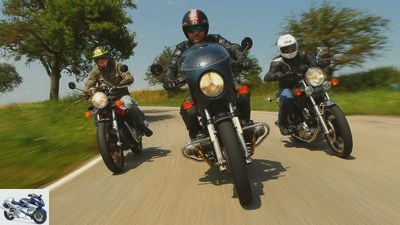
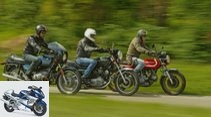
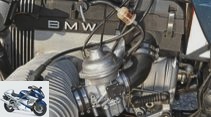
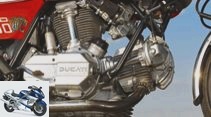
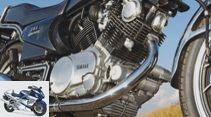
29 photos
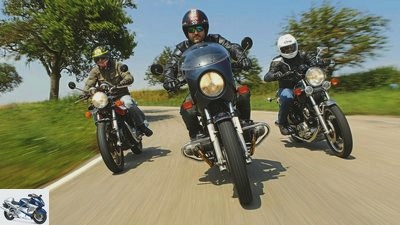
bilski-fotografie.de
1/29
On the move with the BMW R 100, the Ducati SD 900 Darmah and the Yamaha TR 1.
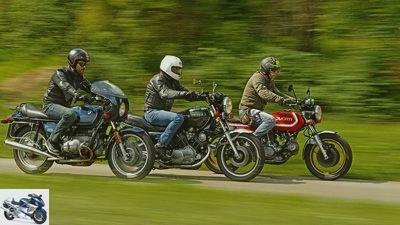
bilski-fotografie.de
2/29
On the move with the BMW R 100, the Ducati SD 900 Darmah and the Yamaha TR 1.
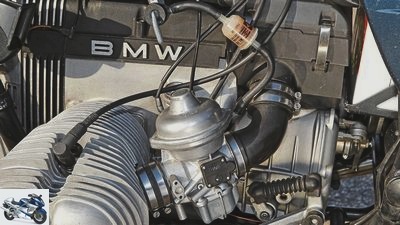
bilski-fotografie.de
3/29
On the move with the BMW R 100, the Ducati SD 900 Darmah and the Yamaha TR 1.
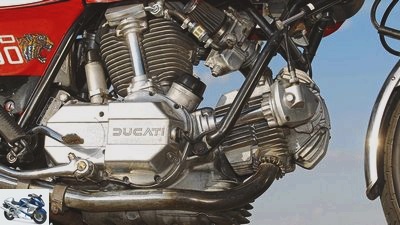
bilski-fotografie.de
4/29
On the move with the BMW R 100, the Ducati SD 900 Darmah and the Yamaha TR 1.
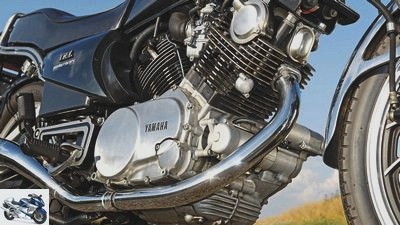
bilski-fotografie.de
5/29
On the move with the BMW R 100, the Ducati SD 900 Darmah and the Yamaha TR 1.
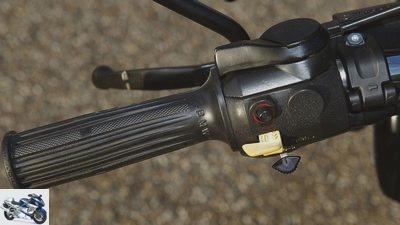
bilski-fotografie.de
6/29
BMW R 100: Now also user-friendly with a choke lever on the handlebars. Turn signal switch without reset function.
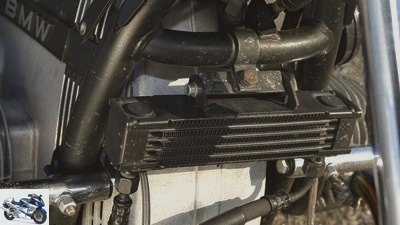
bilski-fotografie.de
7/29
BMW R 100: The oil cooler from the factory accessories helps to keep the temperature of the 2.25 liters of engine oil within a tolerable range.
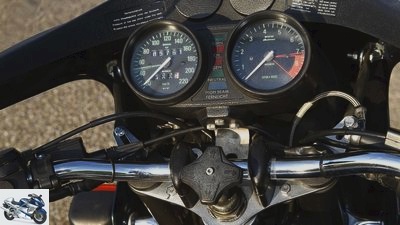
bilski-fotografie.de
8/29
BMW R 100: The cockpit offers easy-to-read clocks (which tend to fog up) and various (faintly glowing) control lamps .
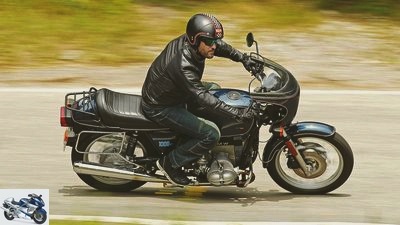
bilski-fotografie.de
9/29
On the move with the BMW R 100, the Ducati SD 900 Darmah and the Yamaha TR 1.
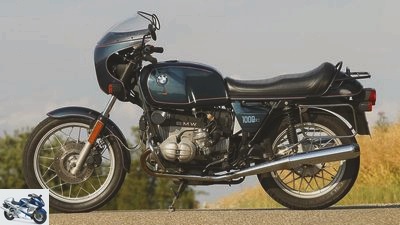
bilski-fotografie.de
10/29
On the move with the BMW R 100, the Ducati SD 900 Darmah and the Yamaha TR 1.
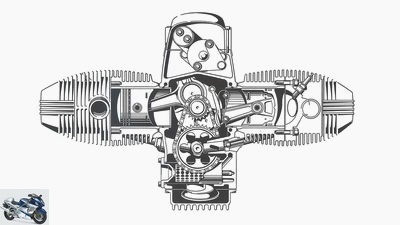
bilski-fotografie.de
11/29
BMW R 100: The simply structured, but maintenance-friendly boxer in the largest (series) expansion stage.

bilski-fotografie.de
12/29
1976: The predecessor R 100/7 represents the significantly weaker basic version of the / 7 series with 60 hp, but slightly lighter at 215 kilograms. Price (1976): 8,590 marks
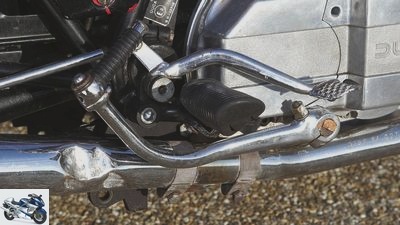
bilski-fotografie.de
13/29
Ducati SD 900 Darmah: Kick instead of pressing a button: In view of the dismantled electric starter, the long, curved lever is extremely important.
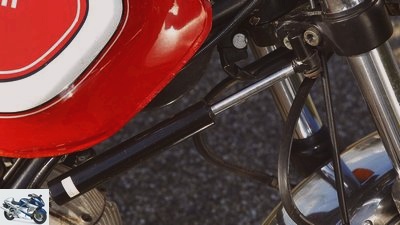
bilski-fotografie.de
14/29
Ducati SD 900 Darmah: The standard steering damper prevents the front wheel from trampling hard over cross joints.
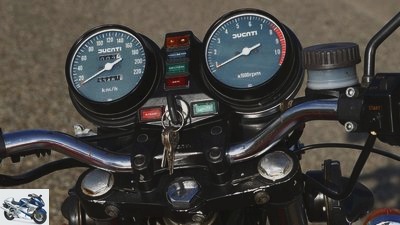
bilski-fotografie.de
15/29
Ducati SD 900 Darmah: Accurate Japanese Nippon Denso watches in the cockpit make Ducati drivers think of Honda.
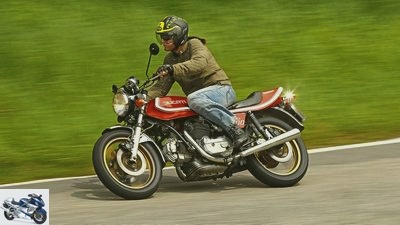
bilski-fotografie.de
16/29
On the move with the BMW R 100, the Ducati SD 900 Darmah and the Yamaha TR 1.
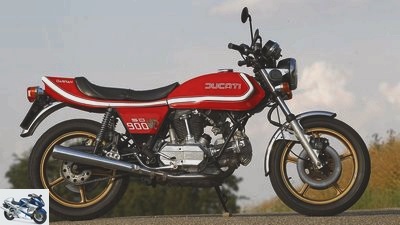
bilski-fotografie.de
17/29
On the move with the BMW R 100, the Ducati SD 900 Darmah and the Yamaha TR 1.
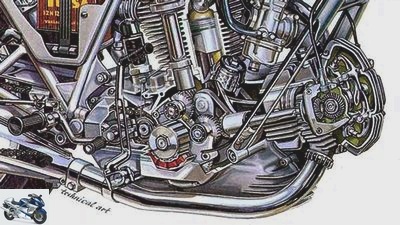
18/29
Ducati SD 900 Darmah: Wonderful technology: Ducati-V2 with speed-fixed, desmodromic valve control via the camshafts driven by vertical shafts
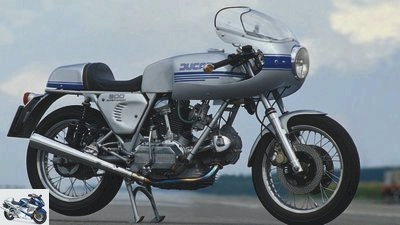
19/29
1975: With the vertical shaft V2 with desmodromic valve control and the super stable chassis, the Ducati 900 SS once set standards for sports motorcycles. Price: 11,800 DM
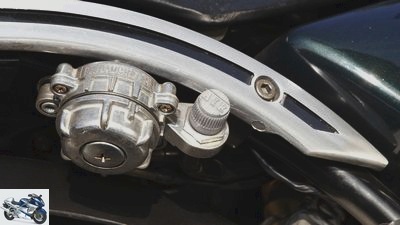
bilski-fotografie.de
20/29
Yamaha TR 1: The damper characteristics of the air pressure-assisted shock absorber can be adjusted six times using the adjusting wheel
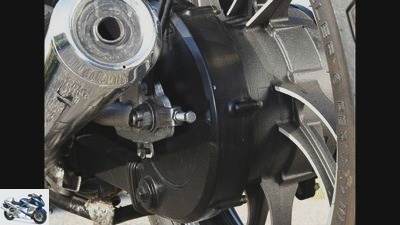
bilski-fotografie.de
21/29
Yamaha TR 1: The closed grease chain case increases the service life of the chain and makes a cardan maintenance-free.
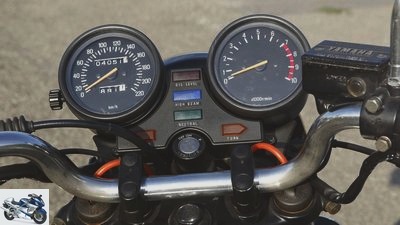
bilski-fotografie.de
22/29
Yamaha TR 1: Clearly drawn, classic cockpit with a very precise display and almost virgin mileage.
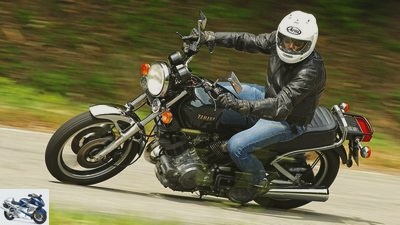
bilski-fotografie.de
23/29
On the move with the BMW R 100, the Ducati SD 900 Darmah and the Yamaha TR 1.
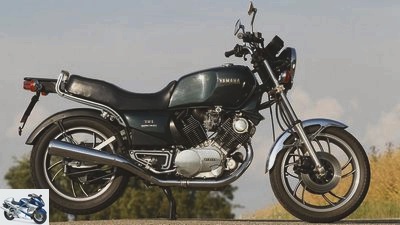
bilski-fotografie.de
24/29
On the move with the BMW R 100, the Ducati SD 900 Darmah and the Yamaha TR 1.

25/29
Modern technology: ohc motor with separate drive shaft for the timing chain, monocoque, cantilever rocker.
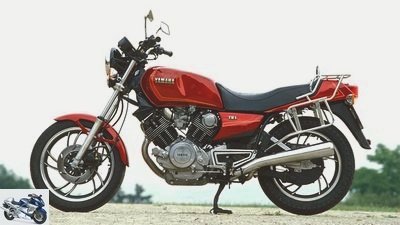
26/29
1982: The facelift includes the brakes, cylinder heads, seat and rear section. Price (1984): 8,025 marks
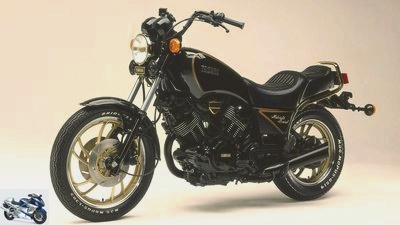
27/29
1983: Softchopper sister: Already known in the USA as the Virago with 920 cm³, the combination of XV 750 (with cardan shaft) and TR 1 engine as XV 1000 did not come to Germany until 1983
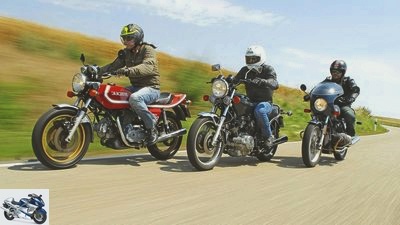
bilski-fotografie.de
28/29
On the move with the BMW R 100, the Ducati SD 900 Darmah and the Yamaha TR 1.
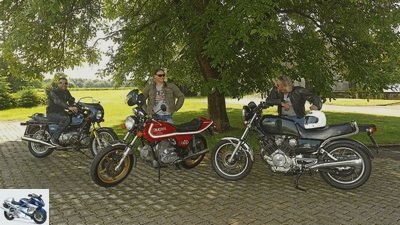
bilski-fotografie.de
29/29
On the move with the BMW R 100, the Ducati SD 900 Darmah and the Yamaha TR 1.
BMW R 100, Ducati SD 900 Darmah, Yamaha TR 1 in a classic comparison
Twins with strong characters from the 1980s
Content of
With the TR1, Yamaha brought a 1000 V2 in the early 80s, which should compete with the big European twins. We went on tour with the two-cylinder competitors from BMW and Ducati to clarify why the TR1 didn’t really succeed at the time.
Anyone who in 1981 was toying with a motorcycle that offered a decent displacement and sufficient power, but didn’t feel like the increasingly numerous four or even six-cylinder engines, could fall back on a selection of characterful twins. Still, or even more than ever. In addition to the well-known and proven Guzzis, the BMW two-valve boxers and the mostly sporty Ducati models with the 90-degree V2, a Japanese man has now pushed into this segment. With the TR 1, Yamaha presented a classically styled touring machine at the IFMA in Cologne in 1980, which had a lot to offer with unusual technology, but foregone high-performance performance. With its 71 hp, it ranks well among the ranks of the BMW and Ducati twins that were comparable at the time and were suitable for touring. Ducati? Yeah right. After all, Ducati had already offered the great king shaft motor in touring garb with the 860 GT / GTS series. The successor model from 1977 even had the more elaborate heads with the desmodromic valve control and became popular with connoisseurs as the SD 900 Darmah. So for this comparison we choose motorcycles from 1981, so we use the then freshly revised one-liter series of BMW boxers and the R 100 base model, the successor to the R. 100 T. It already has numerous improvements.
Buy complete article
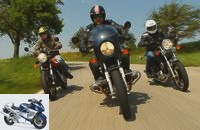
BMW R 100, Ducati SD 900 Darmah, Yamaha TR 1 in a classic comparison
Twins with strong characters from the 1980s
BMW R 100 – torque instead of speed
Our photo model in beautiful Atlantic blue metallic belongs to boxer specialist Jochen Siebenrock and is equipped with the S-paneling, which was offered as an optional accessory at the time, as it was often ordered by aesthetes. The BMW has another, non-standard feature inside – a Big Bore kit with 68 mm pistons and 1070 cm³ displacement is installed, which brings a good ten hp more power and a significant increase in torque. In addition, the engine has double ignition and an oil cooler. Knowing how a normal R 100 with its 67 hp works, we decided to use this neat specimen for the comparison, also out of curiosity as to what can still be got out of the boxer with a thousand.
So when I pick up the BMW, I swing myself into the high saddle in curious anticipation. With only a short use of the choke, the boxer jumps on with the familiar loud click of the starter and soon runs smoothly without assistance, with a modest idle speed of just over 1,000 rpm. One of the pleasant innovations comes into its own here immediately – the choke lever that has moved to the left handlebar fitting and is now easy and practical to use. The idle indicator light glows pale, hardly noticeable in bright sunlight. Above the two easy-to-read round instruments, there would be space provided for the additional instruments voltmeter and time clock – only plastic lids are emblazoned here as placeholders. Pulled by the tight spring, the side stand clicks into place, the clutch pleases with very little manual force, and I put first gear into gear. The boxer hangs well on the gas, is cultivated with all the typical shaking and feels like any large two-valve engine. Gear changes, as we are used to, should be done with caution and care, hectic quick switches find themselves all too abruptly in the nirvana of the gearbox and reap loud scratching and cracking.
bilski-fotografie.de
BMW R 100: The oil cooler from the factory accessories helps to keep the temperature of the 2.25 liters of engine oil within a tolerable range.
It quickly becomes apparent how the boxer behaves below 2,500 rpm, but also how clearly it vibrates between 2,500 and 3,000 rpm, which is felt more pithy than the production version. On the other hand, there is an extremely astonishing smoothness that lasts into the upper regions, if you reach them, because you don’t necessarily have to turn this twin to experience full thrust. Yes, you can feel the increase in performance and look in amazement at the speedometer, knowing full well that the series-thousands is also doing well. The BMW shakes intermediate sprints during overtaking maneuvers, say from 100 to 140 km / h, from the cardan shaft so casually that it is a real pleasure.
It is always amazing how the boxer turns into a barely noticeable quiet step from medium revs – respect for this running culture. This motor, which almost encourages a sporty driving style, now combines this virtue with an active seating position on the one hand, i.e. front-wheel-oriented and leaning high over the short tank towards the wide handlebars, but on the other hand is also comfortable for touring. The leg posture is relaxed, with long-legged people having to watch as they thread their shins / feet behind the carburetor and cylinder. Only the wide but angular bench could cause trouble in the long run and maltreat your thighs. And whoever moves in the continuous speed range above the 3,000 mark does not have to worry about numbness of hands, feet or buttocks.
As is well known, the Brembo fixed calliper brakes represent a real improvement – the new stoppers can really shine in terms of controllability, bite and effect. Thanks to the soft, yet not entirely spongy chassis set-up, the BMW can also take on curvy country roads with moderate surfaces. Before braking, however, it is still advisable to shift down with double-declutching before the curve, so as not to drag the elevator effect of the cardan drive into the lean position. The tail sags all too clearly when you take off the accelerator, just as it lifts and hardens again when you accelerate. Abruptly releasing the accelerator from a high speed also briefly causes unrest in the chassis, which does not necessarily shine with the best straight-line stability and can sometimes be tempted to stir. What in turn benefits brisk cornering pleasure is the easy turning behavior, the almost playful maneuverability and the willingness to fall into an inclined position. The euphoria is only slowed down a bit at the evening stop, when the always fragile ignition key in the fiddly handlebar lock on the front left of the steering head has to be turned when parking. But especially when the main stand is to be parked – the translation of the lever is completely wrong, parking becomes unnecessary heavy lifting. An athletic exercise at the end of the day.
Ducati SD 900 Darmah – physically demanding
Speaking of sport: If the BMW boxer clientele is generally ascribed a casual cosiness, then almost everyone certainly associates the term sport with the Ducati brand. After all, sporting success shaped the reputation, sporty models with powerful V2 engines hit the same line. Just think of the 750 Sport, the 750 SS and the 900 SS. Our second bike in this lap got the engine from the latter – practically the same heart beats in the Darmah as in the 900 SS. At least in 1977, as the SD 900 Darmah was added to the program as a tour variant. Because while the 900 SS was delivered again in 1978 with the large, open 40 mm carburetors, Darmah stayed with the 32 mm Dellortos with air filters until the end of production.
As the successor to the touring models 860 GT, GTS and, most recently, the 900 GTS, all with the 863.5 cm³ Konigswellemotor and valve springs, the Darmah now trumps as the first touring Ducati with the desmodromic, the valve control. Still a sporty motorcycle, but with a high, wide handlebar and the option to go on a trip as a couple. The engine is designed for more power in the lower speed range than for peak power and high top speed. Whoever came up with the idea of giving the SD 900 the nickname Darmah, which goes back to an Indian King Tiger, has not been passed down exactly. Whoever is responsible for the new tank / seat design, yes: Leopoldo Tartarini designed it. As is so often the case with the Italians, form was more important than function – the tank only holds 15 liters and doesn’t really match the touring demands of the 900s.
The sheer common sense, however, shows in the choice of the (more expensive) Bosch HKZ ignition including the new generator and wiring harness. More solidly processed than the previously installed Marelli unit, the system draws its power from the battery, which is charged by the normal 200-watt generator on the right-hand crankshaft stub. The small additional ignition generator of the Marelli system on the left stump could thus be omitted.
bilski-fotografie.de
The standard steering damper on the Ducati SD 900 Darmah prevents the front wheel from twitching as it tramples over cross joints.
Darmah also has an innovation to offer when it comes to gearshifts: The new automatic gearshift was used for the first time on the left-hand side of the engine, and from 1978 it was standard in all Konigswellen twins. The Campagnolo Speedline bikes that were initially installed, which were prone to breakage and even led to accidents, have long since been taken out of service. In mid-1978, Ducati importer Roth had all vertical shaft twins delivered up to then converted to the stable Campagnolo racing wheels at its own expense. This is exactly what our photo bike carries, of course. It belongs to Reinhold Baier, who owns a collection of pithy twins – including Triumph, Moto Guzzi and Harley. The 58-year-old bought his Darmah second-hand in 1985 and “provided it with original and customary optimizations”, as he explains. These are open Conti bags and K&N air intake funnel (the original, huge air filter housing was omitted), the starter was dismantled together with the 34 Ah (!) Car battery and a 900 SS engine side cover was installed without an ugly starter sprue and the main stand was unscrewed. “All of this saves 18 kilos,” explains Baier.
You should be used to riding the Duc so that it doesn’t degenerate into sweaty actions. Once it is running, then with a robust sound from the Conti bags and with a good bang from the basement. Well, it should be over 2,000 tours, otherwise the V2 tends to sputter under misfires and starts to jerk, but it kicks off tremendously. Accompanied by robust vibrations at virtually any speed, the V2 never makes a secret of its existence as an internal combustion engine. Exactly such twins will one day be pensive and mournful for future generations of electric motors. The L-Twin seems to feel most comfortable between 2,500 and 5,000 tours and delights the driver with plenty of pressure, but also turns up to 8,000 rpm if necessary. But a look at the torque curve proves it: The highest torque is available at 6,000 rpm, and shifting here makes perfect sense.
Just as powerful as the pressure in the middle are the manual forces – on the right to open the Dellortos, on the left to pull the clutch. Not a bike that you wanted to ride from stop to stop at traffic lights all day through Rome. That is not what it is intended for. At a moderate height you sit on the moderately comfortable bench and enjoy a relaxed, slightly bent upper body posture towards the broad, comfortable handlebars. The legs, on the other hand, are surprisingly angled – the high pegs allow the athlete to shine through in the tiger. You get used to the long first gear in the otherwise well-stepped five-speed gearbox, but thanks to the relatively short overall ratio you can enjoy great torque in the last gear on fast, winding passages. This is where the 900er lies like the proverbial board, no wobbling, no swinging, it traces its exact path and can be willingly turned from one incline to the other. Splendid. Even tight turns are more light-footed than one might suspect given the long wheelbase. Braking before the hairpin should be initiated early, however, the Brembo calipers decelerate properly in cooperation with the cast iron discs, but without any real bite and require (once again) a good grip. The gear steps also want to be sorted vigorously and without hectic – long shift paths remind you to be patient when changing gears.
As enjoyable as it is to wander on well-developed country roads, a few dozen kilometers of motorway bring a certain disillusionment. The stable driving behavior is bought at the price of a board-hard tuning that takes revenge on every transverse joint and every paragraph. The fork responds unwillingly, and the rear shock absorbers allow any bumps to pass through to the driver when dry. Long stretches of motorway could end up with an orthopedic surgeon.
Blunt straight driving means that I have time to let what I see Switches and instruments look familiar to me, they come from the Japanese supplier Nippon Denso. The switches are, for example, identical to those of the Suzuki GS 750, the speedometer and tachometer are also known from Honda’s CB 750 K6. Designer Taglioni was simply fed up with the anger of previous customers and complaints about inaccurate and leaky Smiths and Veglia watches.
There is no doubt that the Italian impresses, to put it in cliche-laden words: the Darmah is a men’s bike – the Tiger calls for an energetic tamer.
Yamaha TR 1 – unexpectedly agile
On the other hand, the conceptually much younger Yamaha TR 1 behaves completely differently. Allegedly inspired by the desire of European dealers for a sporty thousand, the Yamaha technicians developed a 981 cc V2 and a chassis with advanced features. When the TR 1 was presented at the IFMA in Cologne in 1980, however, it had long been defined as a classic-looking touring machine. The 75-degree V2, consisting of two identical cylinders rotated by 180 degrees to each other, delivers “only” 71 hp, but delivers its ample torque of 81 Nm at 5,500 rpm. The V2 is designed with a short stroke in order to keep the piston speed as low as possible and the overall height low, as chief developer Hasegawa explained at the time. Technical effort was made everywhere: the camshafts are driven by tooth chains, the drive chain to the rear wheel runs in a closed chain case filled with one liter of lithium grease. The monocoque frame, which integrates the engine by means of five screw connections, consists of two welded pressed sheet metal parts, the rear suspension is provided by a cantilever swing arm.
Does the technical effort pay off? She stands there stretched out, a long wheelbase and low seat height characterize the appearance. The design of the TR 1, type 5A8, was controversial at the time and still is today, only the second version 19T from 1982 was a bit more pleasing with the modified rear. The hardly used TR 1 from Yamaha dealer veteran Manuel Wahl (www.motorcorner.de), to whom – like Jochen Siebenrock – we owe our thanks for leaving it, presents itself in subtle dark green, almost British-elegant. The starter motor, which is positioned in an exposed position in front of the engine, starts its work with loud metal grinding, and the V2 comes to life with a dull two-cylinder chatter.
bilski-fotografie.de
Modern technology in the Yamaha TR 1: ohc engine with separate drive shaft for the timing chain, monocoque, cantilever swing arm.
It feels like it is somewhere deep down in the engine room, the engine is pounding, you know it is there, confident and calming, but acoustically subtle and hardly noticeable in terms of vibration. Only a slight tremor goes through the load, not disturbing at any speed, never intrusive. The first gear, which has a long ratio, engages hard but honestly, and the TR 1 starts moving with little more than idle speed. The shifting travels are quite long, here too the left foot has to act with a little force. The engine accelerates steadily, without a kick, unspectacularly, but always gives the good feeling of always having enough reserves.
The wide, well-padded bench, which, together with the rather high, wide handlebars, guarantees a very relaxed riding position, the most comfortable in comparison, also proves to be pleasant. The pegs should be mounted a bit lower, the legs a little less angled, then everything would be perfect.
The Yamaha proves to be unexpectedly agile in tight corners, given the 19-inch front wheel. It turns in relatively lightly, hardly tilts and remains neutral in all kinds of radii. It follows the chosen line precisely, at least until bumps come into play. The suspension and damping, especially the hindquarters, now seem to be overwhelmed, the stern sags and tends to pump. Maybe we should experiment a little more with the air support of the fork and shock absorber? Nothing dramatic. Also not the fact that the double disc brake at the front only works when you grasp it strongly and then rather blunt and only slows it down moderately. The easy-to-dose, effective drum brake at the rear helps. The longer I am on the TR 1, the more I am convinced by its supposedly boring concept. It is hardly less stable and is similarly dynamic, if less dramatic than the Ducati. And it offers almost the agility and smoothness of the BMW, with at least equivalent travel comfort. The Yamaha delivers perhaps the best compromise and the misunderstood alternative to the BMW or Ducati. Even if, unfortunately, far too few recognized this in the three years of its construction.
Price comparison of used 1980s Twins from Germany
1000PS marketplace app
The prices for the used classic cars are relatively fair.
Twins from the 1980s still seem to be an insider tip on the used market. The selection isn’t huge, but the prices are very fair for the pretty vintage cars. Here is an overview of used twins from the 1980s: used 1980s twins from Germany.
Related articles
-
Short test Yamaha XVZ 1300 AT Royal Star Tour Classic
Short test Yamaha XVZ 1300 AT Royal Star Tour Classic revamped Front window, chrome all over and leather case under Sissy’s bar at the back – with good …
-
Ducati Hypermotard 939, Yamaha MT-09 and Aprilia Dorsoduro 900 in comparison test
Arturo Rivas Ducati Hypermotard 939, Yamaha MT-09 and Aprilia Dorsoduro 900 Funbikes in comparison test Now seriously: Have fun and reason …
-
Ducati Panigale R and Yamaha YZF-R1M in the track test
24 pictures www. 1/24 Two completely different engine concepts are put to the comparison test. www. 2/24 The tank …
-
Ducati Monster 1200, KTM 690 Duke R and Yamaha MT-09 in comparison
www.bilski-fotografie.de 42 pictures bilski-fotografie.de 1/42 Ducati Monster 1200, KTM 690 Duke R and Yamaha MT-09 in the comparison test bilski-fotografie.de …
-
Comparison test: Ducati Diavel, Suzuki B-King and Yamaha Vmax
Jahn comparison test: Power Bikes 2011 Ducati Diavel, Suzuki B-King and Yamaha Vmax Content from Big appearance, powerful sound waves, pressure from all …
-
Comparison test muscle bikes Ducati Harley-Davidson Suzuki Yamaha
Gargolov 24 pictures Gargolov 1/24 The four muscle animals. Gargolov 2/24 Yamaha Vmax – Yes, that fits. The surge of combustion of the 200PS has to go through four …
-
Yamaha MT-07, Kawasaki ER-6, Suzuki Gladius 650 and Ducati Monster in the test
Jahn 39 pictures Jahn 1/39 Where I am is in front – the MT-07 is addicted to curves. Jahn 2/39 Less saved: At least the fork can be …
-
Naked bikes from Ducati, Triumph and Yamaha put to the test
32 pictures 1/32 Ducati Streetfighter S / Streetfighter 848, Triumph Speed Triple R / Street Triple R and Yamaha FZ1 / FZ8 in …
-
Superbike comparison test: Ducati 996 SPS against Yamaha YZF-R7
Superbike comparison test: Ducati 996 SPS against Yamaha YZF-R7 Numerus Sausus These machines are not for everyone. If you really want to challenge one…
-
Classic motorcycle Zundapp KS 175
Sven Krieger 23 pictures Sven Krieger 1/23 With the help of a liquid-cooled 17 HP machine, Zundapp wanted to put out the Japanese conflagration in 1976 …